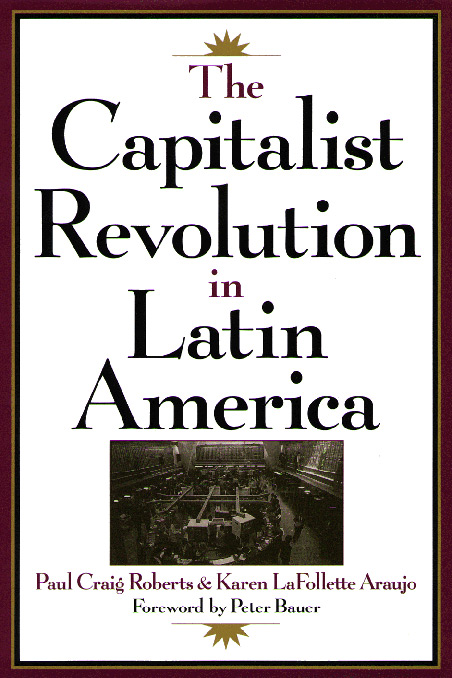
| List Price: | ||
| Price: | $6.99 | |
| Discount: | $20.96 (Save 75%) |
| Formats |
Hardcover |
eBook |

| List Price: | ||
| Price: | $6.99 | |
| Discount: | $20.96 (Save 75%) |
| Formats |
Hardcover |
eBook |
Overview
While the political and social upheavals that have transformed Eastern Europe and the former Soviet Union have attracted great interest, an even more remarkable revolution has been taking place next door to the United States and Canada—the spread of free market capitalism throughout much of Latin America.
For years, Latin American economic development lagged despite abundant natural resources, vast fertile lands, and a sophisticated culture. This was because Latin American nations were slow to discard the economic and social controls inherited from their Spanish colonial masters, who had ruled by selling government privilege and by suppressing indigenous markets for goods, services, and capital.
This book describes the efforts to combat established local plutocratic elites and international agencies in order to privatize state industries and establish independent markets. The author re-examine the orthodoxies of international development and the regulation of markets, and point to the success of rapidly growing, open markets in Mexico, Argentina, and Chile. This book provides an insightful portrait of the dramatic economic turn-around, with crucial lessons for the United States.
Contents
- Chapter 1: Latin America on the Rise
- Chapter 2: The Economic Transformation of Latin America
- Chapter 3: The Blocked Society
- Chapter 4: Development Planners in Their Heyday
- Chapter 5: Latin America’s Statist Traditions
- Chapter 6: Outdated International Development Institutions
- Chapter 7: Implications of Latin American Capitalism
Detailed Summary
- Latin American countries, especially Mexico, Chile and Argentina, have dramatically improved their economies since the early 80’s. The value of the Mexican stock market jumped from $15 billion in 1988 to $146 billion at the end of 1992. Argentina has controlled inflation and achieved economic growth. Chile had 8.2% economic growth in 1995 even after eleven years of continuous growth.
- The economic benefits of the expansion have helped all levels of society. The middle class is growing, and governments are able to devote more resources to helping the poor because they are no longer paying for the losses of state owned corporations. For example, the Chilean healthcare system, which is mostly privatized, has worked. Chile’s infant mortality rates have fallen from 74 deaths to 17 deaths per thousand between 1970 and 1992.
- The market-oriented programs have gained widespread support from the general citizenry. A December 1991 poll in Mexico found that “56 percent of the population ere favorably disposed toward the government’s reorientation of the economy to the private sector.”
- The developed world is partially responsible for the earlier failures of Latin America’s attempts to achieve prosperity because of its insistence on failed government solutions. The World Bank estimated in a report released in 1993 that only 26% of its projects could be deemed successful. To prevent further mistakes, the World Bank and other international governmental lending organizations should be disbanded or privatized.
Like the fabled city of gold, Latin American prosperity has seemed tantalizingly difficult to attain. Finally, real progress may have come to the region. This new development is based on a solid market footing that has replaced corrupt government projects with private investment and growth. Just as the explorers searching for the city of gold brought back valuable information about regions through which they traveled, Roberts and Araujo show that the Latin American experience contains valuable lessons about the policies that nations should foster and avoid. Socialism’s failures in Latin America were inevitable and predictable.
Historical context
The authors place the changes that have occurred in the region in a wide context by looking back to the area’ s colonial roots. The Spanish government created a situation in which political connections could ensure profitable monopolies while entrepreneurship was of little benefit. Public offices were lucrative means to economic advancement and could be bought and sold. These tendencies toward mercantilism were not expelled with Spanish authority. In fact, the situation become worse during the years following World War II when developed nations advocated greater government intervention in the economy as part of their aid programs. Roberts and Araujo are quick to point out the irony of this proposal which runs counter to the system under which developed nations had achieved their prosperity. Economists advocated the influx of outside aid to capitalize the economies while believing that trade would only hamper growth. Pursuing these policies, governments built huge public works projects and imposed oppressive tariffs.
Economic change
Recent economic history is the real story in this book. Suddenly, Latin America is doing something right. These nations have become models for the rest of the world. For instance, Chile has one of the world’s few fully funded and privatized pension programs. This change has dramatically increased investment in Chile and abroad. The new system offers the promise of much higher retirement benefits for those involved. The average Chilean was quick to see this and about 25% of pensions moved to a private company in just the first month of the new programs’ operation. Why have these changes occurred? Quite simply, the authors suggest, the governments found they had little choice. With their money supply out of control and the standard of living failing to make progress, many Latin American leaders turned to economic liberalization as their only hope. With a few interruptions, the new course has been working. The authors present a brilliant discussion of how these policies have changed the area’s business culture and incentives structure to unleash the region’s dynamic growth. Certainly, the changes have not been flawless. Often, the government was more interested in the profits from selling off state-owned monopolies rather than in opening up markets to competition. Still, the benefits are indisputable.
Political dimensions
While this book focuses its attention on the economic aspects of the region, it also addresses the politics that caused and resulted from the economic changes. Perhaps most controversial is the case of Chile where economic reforms were instituted by Pinochet’s military dictatorship that handed over power to a democratic regime in 1989. The authors do not deny that the regime committed contemptible acts of political repression nor do they advocate dictatorship as a useful and necessary means of attaining economic reform. However, they do note that in each case of reform a strong leader had to act with strength and vigor to overcome opposition by special interests. This was true in Chile, Argentina and Mexico. Often leaders gained extraordinary support from fed-up citizens for using unconstitutional methods to overcome recalcitrant legislators. As with most of the book’ s points, this issue is illustrated by several informative and interesting antidotes. For example, the authors tell of the Mexican army using a bazooka to enter the house of a well-guarded and corrupt union official.
The economic changes have also brought political consequences. The authors see the recent charges of corruption against Latin American, and particularly Mexican, officials as a sign that these individuals are being held increasingly accountable to the law. Without the powerful control of patronage, the PRI in Mexico and other ruling parties are becoming more truly democratic.
Wider implications
The potential ramifications of change in Latin America are stunning. This book reminds the reader that the region is potentially a bigger economic force than the United States and Canada combined or the European Union. Eventually, the United States may find the region an important source of markets and competition. When this happens, the US will not be successful if it clings to its inefficient social programs and burdensome regulations. Further, the Latin American experience holds important lessons for poor nations that have not yet found the path out of poverty. The authors believe that it is time for a major reconsideration of the role of the international community in development. Poor countries do not need top down foreign aid investment, but rather the economic development that will occur in a well-organized capitalist system.
Praise
“The Capitalist Revolution in Latin America is a compelling blend of substance and ideas—illuminates the ‘why’ of revolution in economies in Latin America—and elsewhere—and the need for revolution in the multilateral financial institutions. Readable and rewarding.”
—GEORGE P. SHULTZ, former Secretary of State, Labor and the Treasury; Distinguished Fellow, Hoover Institution
“Latin America is not a poor content, but rather one impoverished by 500 years of statism. If you want to understand how the market revolution is freeing us from that bondage, you must read this book.”
—JOSE PINERA, former Finance Minister of Chile; President, International Center for Pension Reform
“Eye-opening appraisals of the extraordinary potential of Latin American countries: The Capitalist Revolution in Latin America is essential reading for those who have, or wish to have, commercial relations with our neighboring continent. Roberts and Araujo brilliantly combine a free market philosophical perspective with a proper appreciation of the region’s history.”
—STEVE FORBES, Editor-in-Chief, Forbes
“While the world’s attention has been focused on the demise of socialism and planning in Central and Eastern Europe, the quite remarkable liberalization of markets—both international and domestic—that has occurred in Latin America has gone largely unnoticed. Roberts and Araujo now bring us the story of the tortuous path that has brought capitalism and markets to Latin America.”
—D. GALE JOHNSON, Professor of Economics, University of Chicago
“Lessons from socialist failures have been learned more quickly in Latin America than in Europe or the United States. The Capitalist Revolution in Latin America lays out the record of Latin American accomplishments to date, along with a precautionary assessment of near-term prospects.”
—JAMES M. BUCHANAN, Nobel Laureate in Economic Science, George Mason University
“The lesson of The Capitalist Revolution in Latin America is evident: Only open economies and open socieities provide an adequate framework for prosperity.”
—PEDRO ASPE, former Finance Minister of Mexico
Author
Paul Craig Roberts is Chairman of the Institute for Political Economy, Research Fellow at The Independent Institute, and author of Alienation and the Soviet Economy: The Collapse of the Socialist Era.
Karen LaFollette Araujo is president of the Hemispheric Studies Institute.















